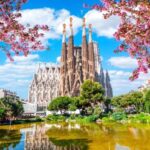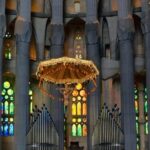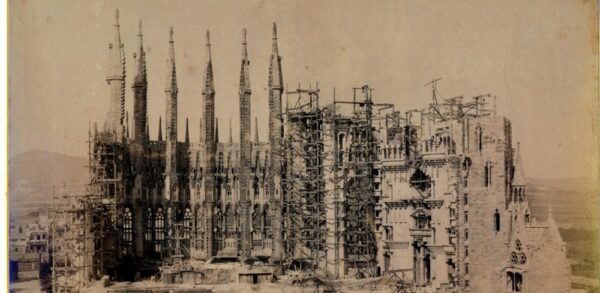
The construction of the Sagrada Familia in Barcelona is a testament to human creativity and perseverance. This iconic basilica, designed by architect Antoni Gaudí, has been under construction since 1882, captivating visitors with its intricate details and innovative design.
As the years pass, the building continues to evolve, embodying both traditional and modern architectural elements. The remarkable aspect of this project lies in its longevity, making **The Remarkable Construction Time of Sagrada Familia in Barcelona** a fascinating topic of discussion for historians, architects, and art enthusiasts alike.
The History Behind the Construction of Sagrada Familia in Barcelona
The history behind the construction of the Sagrada Familia is as intricate as its design. Initiated by architect Francisco de Paula del Villar in 1882, the project took a significant turn when Antoni Gaudí took over in 1883. Gaudí's vision transformed the basilica into a unique blend of Gothic and Art Nouveau styles, which remains unparalleled in contemporary architecture.
Throughout the years, the construction faced several challenges that impacted its timeline, including:
- Financial constraints due to its status as a privately funded project.
- Political turmoil during the Spanish Civil War, which caused significant damage and halted progress.
- The death of Gaudí in 1926, which left the project without its primary visionary.
Despite these hurdles, the Sagrada Familia has become a symbol of resilience and dedication. Each generation of architects and craftsmen has contributed to its ongoing construction, applying modern techniques while respecting Gaudí's original designs. Today, the completion is projected for 2026, marking the centenary of Gaudí's passing.
The construction of this basilica not only tells the story of an architectural marvel but also reflects the cultural and social changes in Barcelona over the past century. As it continues to rise, the Sagrada Familia stands as a testament to the enduring spirit of innovation and craftsmanship.
How the Unique Design Influenced the Construction Timeline of Sagrada Familia
The unique design of the Sagrada Familia, characterized by its organic shapes and complex geometries, significantly influenced the construction timeline of the basilica. Gaudí's visionary approach required innovative building techniques and materials, which were not readily available at the time. As a result, the construction process has been both a challenge and an opportunity for architectural experimentation.
One major aspect of the design that impacted the timeline is the incorporation of natural forms and structures. Gaudí aimed to mimic nature, leading to intricate details that necessitate careful craftsmanship. This has resulted in a construction schedule that is not only about speed but also about maintaining the integrity of Gaudí's artistic vision. Some key factors include:
- Custom-made materials: The need for unique stone carvings and bespoke materials has extended the construction duration.
- Complex structural elements: The basilica's soaring towers and detailed facades require precise engineering, impacting both time and cost.
- Environmental considerations: Gaudí's designs often adapt to the surrounding landscape, which has influenced the pace of construction.
Moreover, the project has evolved through the contributions of various architects and craftsmen over the decades. Each generation has interpreted Gaudí's ideas differently, which has not only kept the design fresh but has also introduced delays as new methods and technologies were integrated. This dynamic, coupled with ongoing funding challenges and external events, has resulted in a construction timeline that reflects both the ambition and the complexity of the Sagrada Familia.
In essence, the unique design of the Sagrada Familia is a double-edged sword; while it has drawn attention and admiration globally, it has also posed significant challenges that have shaped its prolonged construction timeline. As the basilica continues to rise, it stands as a remarkable blend of artistry, innovation, and perseverance, capturing the essence of Gaudí's genius.
Understanding the Challenges Faced During the Long Construction of Sagrada Familia
The construction of the Sagrada Familia has been marked by a multitude of challenges that have tested the resolve of those involved. The combination of financial limitations, political unrest, and the need for innovative construction techniques has created an intricate web of obstacles. These challenges have not only delayed the project but have also shaped its evolution over the years.
One of the most significant challenges has been the ongoing need for funding, as the basilica relies heavily on private donations. The financial strain has led to pauses in construction, forcing architects to adapt plans continually. Additionally, some key challenges include:
- Changing architectural techniques: As construction has progressed, the introduction of new technologies has required adjustments to the original designs.
- Natural disasters: Events such as storms or earthquakes have caused damage, necessitating repairs that pull resources away from ongoing work.
- Public interest and tourism: While the influx of visitors provides funding, it also requires management of construction noise and safety protocols, complicating the workflow.
Moreover, the historical context surrounding the Sagrada Familia has presented unique challenges. The Spanish Civil War caused significant interruptions, resulting in a loss of original plans and materials. Consequently, architects had to reinterpret Gaudí's vision using available resources, which has added layers of complexity to the construction process.
Overall, the Sagrada Familia stands as a testament to the resilience and creativity required to overcome these challenges. Each hurdle has not only tested the feasibility of Gaudí's dream but has also served as an opportunity for innovation, ensuring that the basilica remains a living project that continues to inspire future generations.
Milestones in the Ongoing Construction of Sagrada Familia: A Timeline
The construction of the Sagrada Familia has seen numerous milestones that mark its unique journey. One significant event occurred in 1926, when Antoni Gaudí tragically passed away, leaving behind only a portion of his vision realized. This pivotal moment led to a period of uncertainty regarding the project's direction and continuity.
In 1954, the construction faced a major revival after decades of stagnation. This resurgence was fueled by new funding and a renewed commitment to honor Gaudí's original designs. Throughout the 1980s and 1990s, advancements in technology allowed for a more precise restoration of the existing structures, leading to increased optimism about the basilica's eventual completion.
Another landmark in the timeline occurred in 2010, when the Sagrada Familia was consecrated by Pope Benedict XVI, elevating its status to a basilica. This event not only boosted public interest but also brought international attention to the ongoing construction efforts. Currently, the anticipated completion date is set for 2026, which will commemorate the 100th anniversary of Gaudí’s death.
As construction progresses, each milestone reflects a blend of historical context and modern techniques, demonstrating the resilience and dedication required to bring Gaudí's vision to life. The ongoing journey of the Sagrada Familia continues to captivate architects, historians, and tourists alike, serving as a powerful symbol of cultural identity in Barcelona.
The Impact of Antoni Gaudí's Vision on the Sagrada Familia's Construction Duration
Antoni Gaudí's vision for the Sagrada Familia had a profound impact on the basilica's construction duration. His innovative architectural ideas, grounded in a deep appreciation for nature, demanded a level of craftsmanship and precision that extended the timeline significantly. Gaudí's designs included complex geometries and organic shapes that required not just skilled labor, but also the development of unique construction techniques, which inherently slowed progress while ensuring fidelity to his artistic intent.
Moreover, Gaudí's commitment to integrating the structure into its environment influenced the project's pace. He believed that architecture should harmonize with nature, leading to designs that were not only aesthetically compelling but also structurally challenging. This approach necessitated careful planning and execution, as well as customized materials tailored to meet the unique demands of each element of the basilica. Such considerations inevitably contributed to the extended construction timeline.
Additionally, Gaudí's untimely death in 1926 left the project in a state of uncertainty, with many of his plans and models destroyed during the Spanish Civil War. This gap in leadership resulted in a series of modifications and reinterpretations by subsequent architects, each attempting to stay true to Gaudí's vision while navigating contemporary building practices. As a result, the construction timeline became a reflection of both the ambition of Gaudí's designs and the challenges faced by those who followed him.
In summary, the impact of Antoni Gaudí's vision on the Sagrada Familia's construction duration is evident through the intricate relationship between artistic intention and practical execution. His groundbreaking designs have not only made the basilica a monumental work of art but have also ensured that its construction remains a lengthy and evolving process. Each phase of the project continues to embody the spirit of innovation and creativity that Gaudí championed, making the Sagrada Familia a living testament to his legacy.
Future Prospects: When Will Sagrada Familia Finally Be Completed?
The completion of the Sagrada Familia has long been a topic of speculation, with various projections throughout its construction history. Currently, the anticipated completion date is set for 2026, coinciding with the 100th anniversary of Antoni Gaudí's death. This date serves not only as a tribute to the architect's vision but also as a significant milestone that reflects the evolution of construction techniques and funding strategies employed over the decades.
As the project moves closer to completion, several factors will play a crucial role in determining the final timeline. These include:
- Funding availability: Continued financial support from private donations and tourism is essential for maintaining momentum.
- Technological advancements: Innovations in construction methods can potentially expedite the remaining work, allowing for a more efficient build process.
- Public interest and engagement: Increasing global interest in the Sagrada Familia can lead to enhanced sponsorship opportunities, further securing the necessary resources.
While the 2026 target is ambitious, the history of the Sagrada Familia teaches us that flexibility is essential. Delays are not uncommon, and any unforeseen challenges—such as economic downturns or natural disasters—could extend the timeline once again. However, the commitment to preserving Gaudí's original vision remains steadfast, ensuring that every detail aligns with his artistic intentions.
In conclusion, the future prospects for the Sagrada Familia are as dynamic as its construction history. As it approaches completion, the basilica stands as a symbol of resilience and creativity, embodying the spirit of innovation that Gaudí envisioned. The journey of this iconic structure continues to inspire generations, making it a unique topic of interest for architects, historians, and enthusiasts worldwide.
 Everything You Need to Know About Sagrada Familia Barcelona Tickets
Everything You Need to Know About Sagrada Familia Barcelona Tickets From Sagrada Familia to Barcelona Airport: Convenient Transportation Options for Tourists
From Sagrada Familia to Barcelona Airport: Convenient Transportation Options for Tourists Sagrada Familia Barcelona: Mass Times and Spiritual Experiences
Sagrada Familia Barcelona: Mass Times and Spiritual ExperiencesIf you want to know other articles similar to The Remarkable Construction Time of Sagrada Familia in Barcelona you can visit the category WHERE YOU CAN GO.
Leave a Reply










Read more!